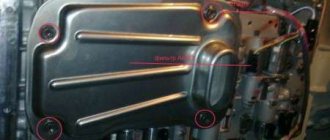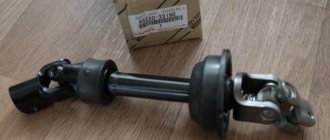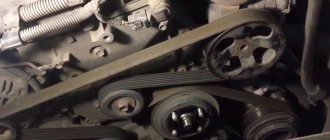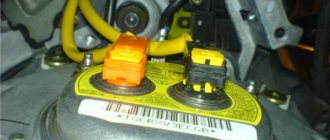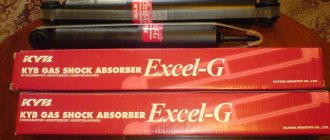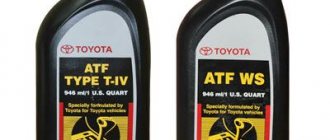Toyota Land Cruiser Prado 120 is a mid-class frame SUV that replaced the Land Cruiser Prado 80 (1995-2002). Production of the new model began in 2002. The car has increased in size and become more spacious. There were versions with three- and five-door bodies, but only the five-door was delivered to Russia. Engines – petrol 2.7 (150 hp) and 3.4 liters (185 hp), as well as a three-liter diesel engine. The engines were coupled with manual transmission-5 or automatic transmission-4. In 2004, restyling took place, as a result of which the updated SUV received new gasoline engines of 2.7 liters (163 hp) and 4.0 (249 hp). The production of the 120th model continued until 2009.
When to change axle oil
The frequency of oil changes in Toyota Land Cruiser Prado 120 axles is 40-50 thousand km. If characteristic signs indicating a deterioration in the useful properties of the oil are detected (turbidity, low level, the presence of sediment and wear products, a specific burning smell, etc.), the oil should be replaced immediately. Waste fluid, as a rule, causes serious damage to transmission parts, which, due to overheating and dry friction, experience enormous stress and fail prematurely.
The most popular articles on the site:
- How often should you change engine oil?
- Oil 5w30 and 5w40 what is the difference
- What oil to pour into the engine in winter and summer
- How long does it take to change the automatic transmission oil?
Oil change instructions
It is recommended to replace fluids at official dealers or service stations: the process will require less physical and time expenditure. If you wish, you can perform this simple operation yourself.
Transfer case
Filling the transfer case of a Toyota Land Cruiser Prado 120 with new oil takes half an hour. According to the manual, the transfer case needs 1.4 liters of lubricant, but it’s better not to risk it, take 2 liter bottles: let it remain, rather than not have enough.
Algorithm of actions:
- Use a hexagon to remove the drain and fill plug.
- Drain the old oil.
- Clean the drain plug from dirt and shavings.
- Screw in the drain plug.
- Pour in oil until it reaches the level of the filler plug.
- Tighten the plugs.
Afterwards, the “working area” is wiped to remove excess lubricant that has leaked out. When filling, it is recommended to use a special syringe or a hose from a bottle of liquid.
Bridges and gearboxes
To change the lubricant in gearboxes, the oil is heated up: just drive it a little just before the process. 1.4 liters are poured into the front differential, 2.4-3.05 into the rear differential, depending on the Prado model.
The algorithm of actions is simple:
- Remove the drain and fill caps.
- After most of the lubricant has drained, the remainder is drawn out with a syringe. This is not necessary: there will be no negative consequences from mixing old and new liquid.
- Clean the drain plug and screw it in.
- New oil is poured before it begins to pour out of the filler hole.
- Screw on the lids.
When unscrewing the front axle covers, problems with the bolts may arise: Prado owners complain that it is very difficult to unscrew them. Some people pour in liquid with a syringe while the drain plug is not removed, others pull back the engine protection with a crowbar, hoping to unscrew the part in this way. Very often, changing the lubricant at the front requires more time and effort.
What kind of oil to fill
Hypoid Gear Oil SX API-GL-5 85W-90 is poured into the front and rear axles of the Toyota Land Cruiser Prado 120 SUV. As for viscosity, in harsh Russian conditions, the most popular is an all-season fluid with a viscosity of SAE 75W-80, 80W-85, 80W-90 or 75W-90. In addition, when choosing an oil, they also pay attention to the brand (Mannol, Total, Eneos, ZIC, Castrol, Kixx) and the appropriate API approval.
So, in the case of Prado 120/150, the best choice would be API-GL-3, 4 or 5. For the most recent copies, GL-5 oil, which contains the largest number of useful additives, is recommended. Below are suitable oils for the rear and front axles of the Toyota Land Cruiser Prado 120.
- Peak Synthetic Gear Oil 75W-90
- Chevron RPM Universal Gear Lubricant 75W-90
- Castrol Syntrax Universal Plus 75W-90.
View oil prices
Toyota Prado 120 2002-2009
Model 2001 release.
Gasoline engines
According to the car's operating instructions, the recommended engine oil for Toyota Prado must meet the following parameters:
- original Toyota Genuine Motor Oil or equivalent lubricants that meet the vehicle manufacturer's lubricant quality requirements:
- universal motor fluids of class SL or SJ with the inscription “Energy Conserving” (energy saving) according to API standards;
- ILSAC certified motor lubricants.
The viscosity of the motor oil is selected according to scheme 5.
Diagram 5. Recommended viscosity for Toyota Prado gasoline engines.
According to diagram 5, if you fill in motor fluids 10w-30, 15w-40, 20w-50 at very low temperatures, then starting the engine will be difficult. For temperatures below +8C it is recommended to pour 5w-30.
Diesel power units
According to the manual, for diesel engines it is necessary to use motor oils with the following parameters:
- liquids corresponding to class G-DLD-1;
- oil classes CF-4 or CF according to API classification (it is acceptable to use CE or CD).
To select viscosity, use diagram 5.
Refueling volumes
The oil volume between the maximum and minimum marks on the Toyota Prado dipstick is:
- 1.3 l if engines are 2TR-FE
- 1.5 liters in the case of 1GR-FE or 5L-E engines;
- 1.2 l for 1KZ-TE engines.
Axle oil for Toyota Land Cruiser & Prado
The gearboxes of Toyota Land Cruiser 100/200 & Prado 120/150, which are the front and rear axles, mainly use technical fluids (gear oils) GL-5 group (on).
Toyota 75W-90 oil (08885-02106): an older standard for use, but it does not “tolerate” significant subzero temperatures particularly well (not lower than -18C°). It performs best in warmer regions. Analogues: Neste 75W-90 Hypoidi S, Castrol 75W-90 Long Life.
Toyota 75W-85 oil (08885-81060): high-quality energy-saving oil, which is recommended for constant use when servicing cars and behaves well at sub-zero temperatures. That is, if you operate a car in the northern regions, then 75-85 will be the best choice for you.
When to change?! The schedule for changing fluid/oil in Toyota Land Cruiser 100/200 & Prado 120/150 is every 40,000 kilometers, but if in most cases you operate the car outside the city, on a highway with low loads, then it is possible to change it at about 60,000 kilometers .
That is, it all depends on how and where the car is used, but it is recommended to do the first oil change at 40,000 kilometers, as required by regulations, because after the parts have been worn in there are a lot of chips in the oil.
Sometimes it is necessary to change the oil in axles/gearboxes at 20,000 mileage. This applies to those who operate the vehicle under heavy loads, such as with a trailer, roof rack, or if a new vehicle is being actively used right away.
How many liters of oil should be poured into the Land Cruiser axle?
| J100 | liters |
| Front axle: | |
| with independent wheel suspension | 1.70 |
| with front and rear differential locking system | 2.65 |
| Rear axle: | |
| with differential lock | 3.20 |
| without differential lock | 3.30 |
| J120 | volume in liters |
| Front axle | 1.4 |
| Rear axle: | |
| without rear differential lock system | 2.50 |
| with rear differential locking system | 3.05 |
| J150 | liters |
| Front axle | 1.4 |
| Rear axle: | |
| without limited slip differential system | 2.65-2.70 |
| with self-locking differential system | 2.55 |
| J200 | liters |
| Front axle: | 1.90 |
| Rear axle: | |
| without rear differential locking system and self-locking differential | 4.20 |
| with rear differential lock and limited slip differential | 4.15 |
Prado 120 oil change
The answer to this question is ambiguous. Now let's talk about the nuances of high-quality engine oil replacement
which must be carried out within the prescribed time frame.
Every car enthusiast understands that it is necessary to change the oil as often as possible. That is: “semi-synthetics” and “synthetics”. If you are going to do all the work yourself, then first select a motor oil that is suitable for the type and brand of engine. Unfortunately, good lubricants are quite expensive, so the price of an oil change does not always please car owners with its affordability. We install new pipes in their place and tighten them with clamps, do not overdo it so that nothing bursts. Most modern automatic transmissions do not require oil changes. They are filled with oil
for the entire service life of the automatic transmission, which, generally speaking, should coincide with the service life of the car. The pressing question for almost every car enthusiast, which is asked from year to year, is when it is necessary to change the engine oil, with what frequency, and whether it is possible to make the change yourself. Changing the automatic transmission oil must be done exclusively at a specialized car service center.
To determine the optimal oil change period, proceed from the manufacturer’s recommendations, the quality of the oil and gasoline used, and, of course, driving style. The more often this operation is performed, the longer the auto engine will work. Replacement
Engine oils in different brands of cars are not very different and follow approximately the same pattern. That is: pouring mineral Dexron-3 if it was semi-synthetic is not allowed.
Before pumping oil, do not forget to tighten the measuring tube! Fill in approximately as much as drained.
Every car enthusiast understands that it is necessary to change the oil as often as possible. The more often this operation is performed, the longer the auto engine will work. Therefore, each auto owner calculates his own acceptable service interval independently.
If the reference book says that “mineral” (such as DeXRon-III) is suitable, you can also pour the next generation of ATF (DeXRon-VI), that is, everything of a higher class. In such automatic transmissions there is no dipstick for checking the ATF level, and on the automatic transmission itself there is usually a plate or sticker that says the box is filled with oil for its entire service life. Then we start the engine and move the automatic transmission selector in all positions for about 10 minutes so that the ATF is well mixed. Therefore, each auto owner calculates his own acceptable service interval independently. Therefore, if you are not sure, do not jack up the car - it is better to look for a hole or bump! There is nothing complicated, the car will not fall if it is on the handbrake and the jack is installed on a flat, hard platform - but you need to understand the responsibility! You can place wooden blocks or bricks under the wheels to prevent the car from rolling. Even novice drivers know that changing the oil in a car is an important procedure that must be performed on average every 10-15 thousand kilometers or once a year if the mileage is shorter. If we look from one side, then, of course, the more often the better, but if we look from the other side of the matter, then high-quality motor oil is not a cheap pleasure, and if you change the oil
once every 3 months, the money will fly away very quickly, and also changing the oil still requires quite a bit of time. Unfortunately, good lubricants are quite expensive, so the price of an oil change does not always please car owners with its affordability. Changing the oil using artisanal methods will not improve the performance of the automatic transmission, will be ineffective, and may even seriously harm your automatic gearbox.
How to choose
Two types of fluid are poured into the transfer case: transmission oil or ATF fluid. On cars with an automatic transmission, ATF is usually filled into the transfer case, and on cars with a manual transmission, the transmission is filled. In this case, often the liquids must match or be completely compatible.
This is due to the fact that usually the connection between the transfer case and the gearbox is made by a single shaft, or one is attached to the body of the other. When mixing liquids, this will avoid the formation of emulsions, foaming and other side effects.
For most modern cars with a transfer case, the manufacturer recommends using GL-5 class gear oils. They protect hypoid gears well, are designed to operate in the most heavily loaded mechanisms and contain extreme pressure additives.
READ Changing the oil in a Nissan Tiida manual transmission
The viscosity characteristics of oils play an important role. Let's look at the meaning of the numbers using 80W90 oil as an example:
- 80 – viscosity at low temperatures
- W – all-season
- 90 – viscosity at high temperatures
If ATF is used, it is better to fill in the original fluid recommended by the manufacturer, or an analogue that has the appropriate approvals.
No drain
In this case, all operations are performed through the filler hole. A syringe tube is inserted into it and the oil is pumped out as much as possible. The procedure for filling new oil is no different from that described above.
After replacement, it is recommended to remove traces of oil from the surface of the transfer case, and after the first trip, inspect for the possibility of leakage.
Answers (1)
The manufacturer recommends filling the axle gearboxes of the 120th Prado with original Toyota Gear Oil 80W-90 Gl-5 transmission oil.
The LSD axle should be filled with special Toyota Hypoid Gear Oil LSD 85W-90.
The transfer case should be filled with 75W90 Toyota Gear oil.
Front axle - 1.4 liters Rear - 2.5-3.05 liters Transfer case - 1-1.4 liters
Replacement interval is every 40,000 km.
PS Pradikov owners often fill in synthetic gear oil 75W90 GL-5 for all components and use it all year round, and the oil is not original. They save money and everything is fine with the nodes. Also, do not forget to change the plug gaskets and bridge washers.
How often to change
There are several different types of transfer cases, and depending on the type of mechanism, the frequency of replacement can vary significantly. Usually this information is contained in the technical documentation for the car and varies in the range from 50 to 100 thousand kilometers.
In addition, operating conditions affect the service life. The transfer case of a car that drives on public roads experiences much less load than that installed on a car that constantly moves off-road.
There is a drain hole
If your car is equipped with a drain plug, you need to unscrew the bolt and wait until the oil drains out completely. The magnet on the plug should be cleaned of wear debris. Degrease the drain hole and plug, apply a layer of sealant and screw the plug into place.
Using a syringe, fill the transfer case with oil until it flows over the edge of the filler hole, then screw the plug onto the sealant.
Check level
On most cars, inspection windows are not provided to check the oil level in the transfer case. Level control and replacement
carried out through the filler hole.
To check, you need to place the car on a flat surface and unscrew the filler bolt, or the control bolt, if any. Usually they are made with a quad or hexagon, or with a wrench. A normal level is just below the fill/check hole.
The need for replacement is determined by taking a small amount of oil. This can be done using a syringe with a flexible tube attached to the end. Black, cloudy, with traces of wear and tear, must be replaced.
How to change
The replacement procedure itself is simple, but is often complicated by the fact that access to the filler hole is difficult. A lift, inspection pit or overpass is also required.
Some car enthusiasts make their own drain hole in the transfer case
to make the complete oil change procedure as easy as possible. To do this, a hole is drilled at the bottom point for the plug and a thread is cut.
You will need:
- A special syringe for pumping out technical liquids (). You can use a medical one, but due to its small volume, the replacement process will be significantly delayed. It’s up to you to decide what’s more valuable – time or money.
- Transfer case oil (transmission/ATF) recommended by the manufacturer or having the appropriate specification.
- Gasket sealant, degreasing liquid.
READ Replacing the Pump on Kalina Video
It is recommended to change the oil after a trip, when it is warm and leaking.
To prevent dirt from getting inside the transfer case, you should clean the surfaces before unscrewing the plugs.


